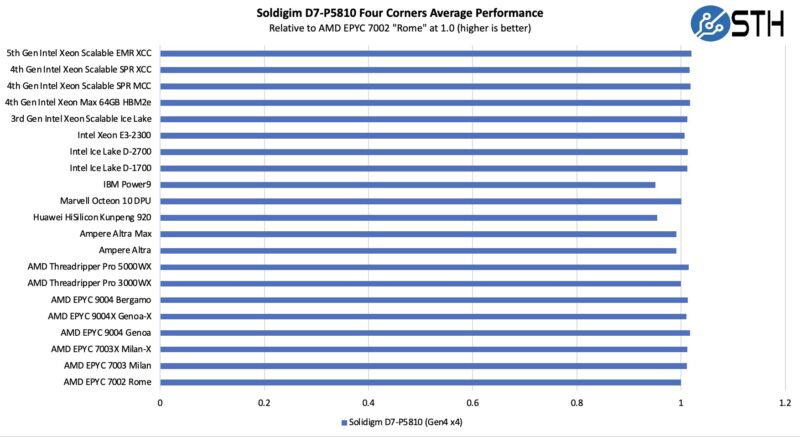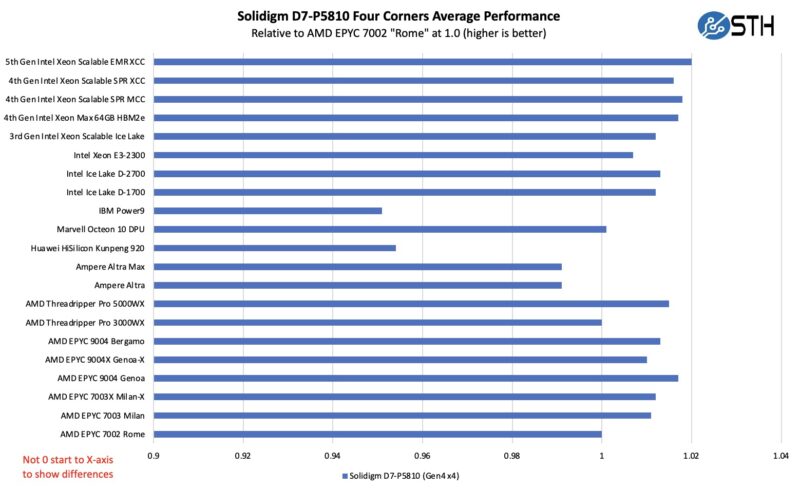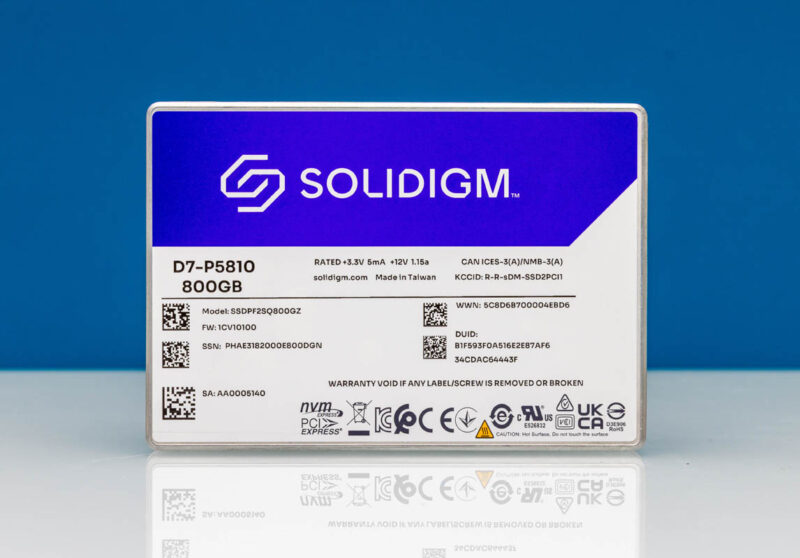Solidigm D7-P5810 800GB Performance by CPU Architecture
If you saw our recent More Cores More Better AMD Arm and Intel Server CPUs in 2022-2023 piece, or our pieces like the Supermicro ARS-210ME-FNR Ampere Altra Max Arm Server Review, Huawei HiSilicon Kunpeng 920 Arm Server piece, you may have seen that we have been expanding our testbeds to include more architectures. This is in addition to the Ampere Altra 80 core CPUs that are from the family used by Oracle Cloud, Microsoft Azure, and Google Cloud. We also managed to test these on the newest generation AMD EPYC Bergamo and Genoa-X SKUs.

Since that is hard to read, we have a zoomed-in view below without a 0 X-axis.

Generally, this drive performed well on the newer PCIe Gen4 and Gen5 x86 controllers. The Arm and IBM Power9 controllers are generally slower than what we see on the x86 side, and that is exactly what we saw here. There are no surprises.
Since we are moving firmly into the era of PCIe Gen5 SSDs and will likely be transitioning to PCIe Gen6 on the CPU side later next year we will start to prune this a bit for the PCIe Gen5 era CPUs now that we have enough platforms to make that a distinct data set.
Expect more on this as we now have many PCIe Gen5 servers and new SSDs launching all the time.
Final Words
At first, we expected the D7-P5810 to replace the now-discontinued Optane DC P5800X SSD. In some ways, it does, given its massive endurance and relatively great latency characteristics, given the use of SLC NAND.

After testing the drive, we feel like we have a better sense of what this product is. This is the cache layer in front of gargantuan storage like the Solidigm D5-P5336 61.44TB SSD. Those massive QLC drives work well for reads but struggle with 4K random writes. The gap in capacity at over 75x for the QLC over the SLC drives and write performance/ endurance characteristics make this a product to cache the hot data in a QLC NAND-backed array. The Solidigm D7-P5810 is probably not the drive you would use as a primary mixed workload SSD. Instead it is a drive tuned for heavy write workloads and as a cache layer device.




Intel SSDs were my goto during the long 6-Gbit SATA era (while supporting 5K Linux servers).
Dumb question:
Would the QLC 60TB running in SLC mode (15TB) perform as well as this? Or would the excess capacity slow it down?
You mentioning it and the SLC mode stuff made me realize we have the capability for 15TB SLC SSDs and nobody is really putting anything into that.
Give us back optane!
FInally, SLC.
This is actually not true SLC, it has QLC dies ran in pure pseudo SLC
Even more hilariously, the QLC drives are 5LC running in QLC
Optane is too good of a tech to allow it to die. Fixes 100% of the problems with NAND.
SLC gets you part of the way there but with the same limitations with all NAND.
I just finished our new SAN – all 2S SPR, 2TB, 2x Bluefield 3 (400GbE), 2x ConnectX7 (400GbE) – 24 x NVMe in a 2U Supermicro chassis.
Tier 0 is 4 servers and 280TB of Optane storage (4x70TB) ZFS with single parity.
Tier 1 is 12 servers and 4PB of Intel Enterprise NAND and dual parity ZFS.
Tier 2 is 45 drive top loaders (3) from Supermicro with 14TB Exos dual 12Gb/s SAS. These are limited to ConnectX6 and 2x100GbE / 200GbE.
Tier 3 is soon to be decommissioned Supermicro 90 drive top loaders.
I Picked up the Optane and NAND drives for less than half cost after the Solidigm branded drives started appearing. Still have over 2PB of NAND and 300TB of Optane in reserve.
Intel NAND was always superior to other NAND and Optane has no peer.